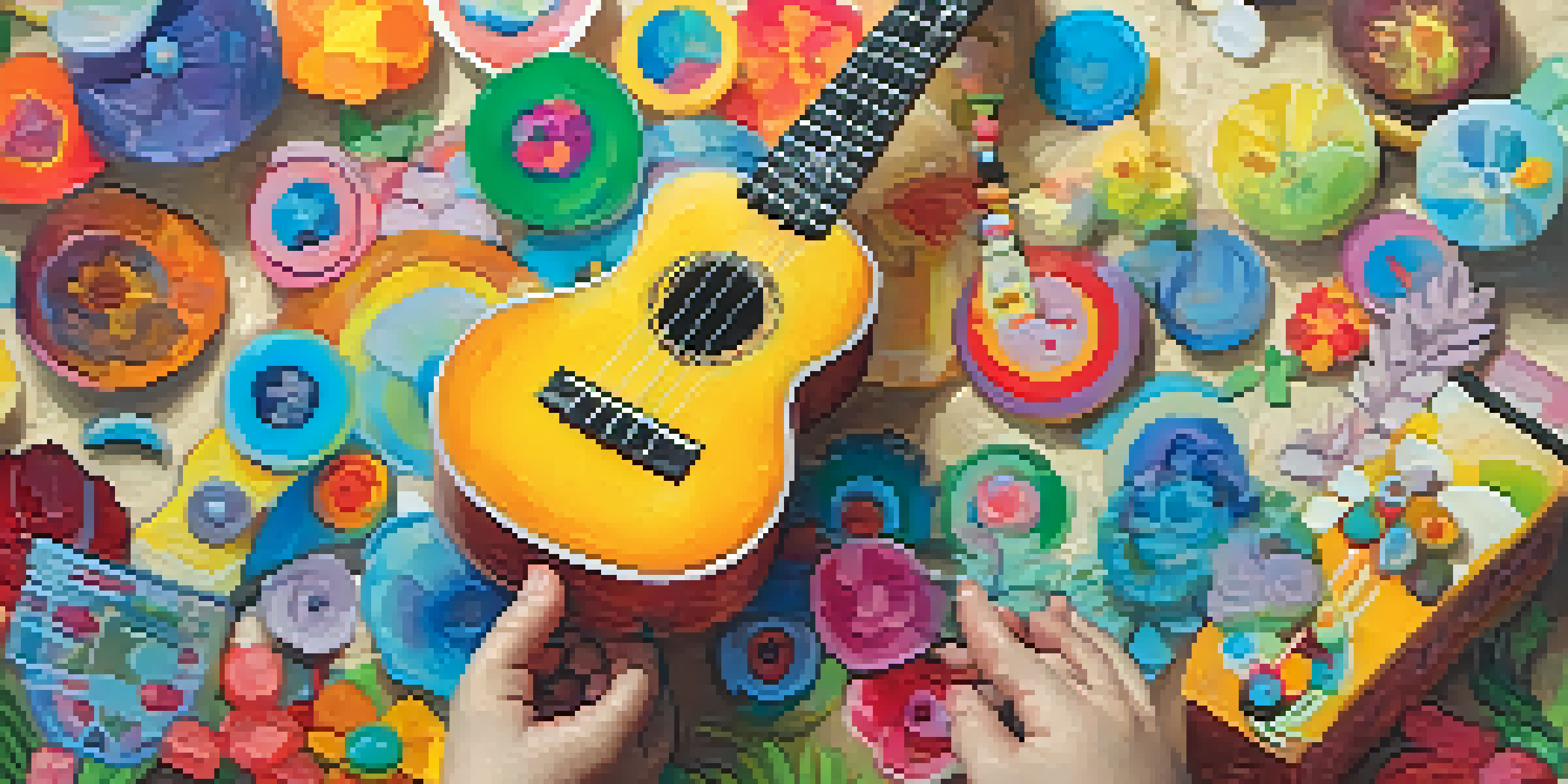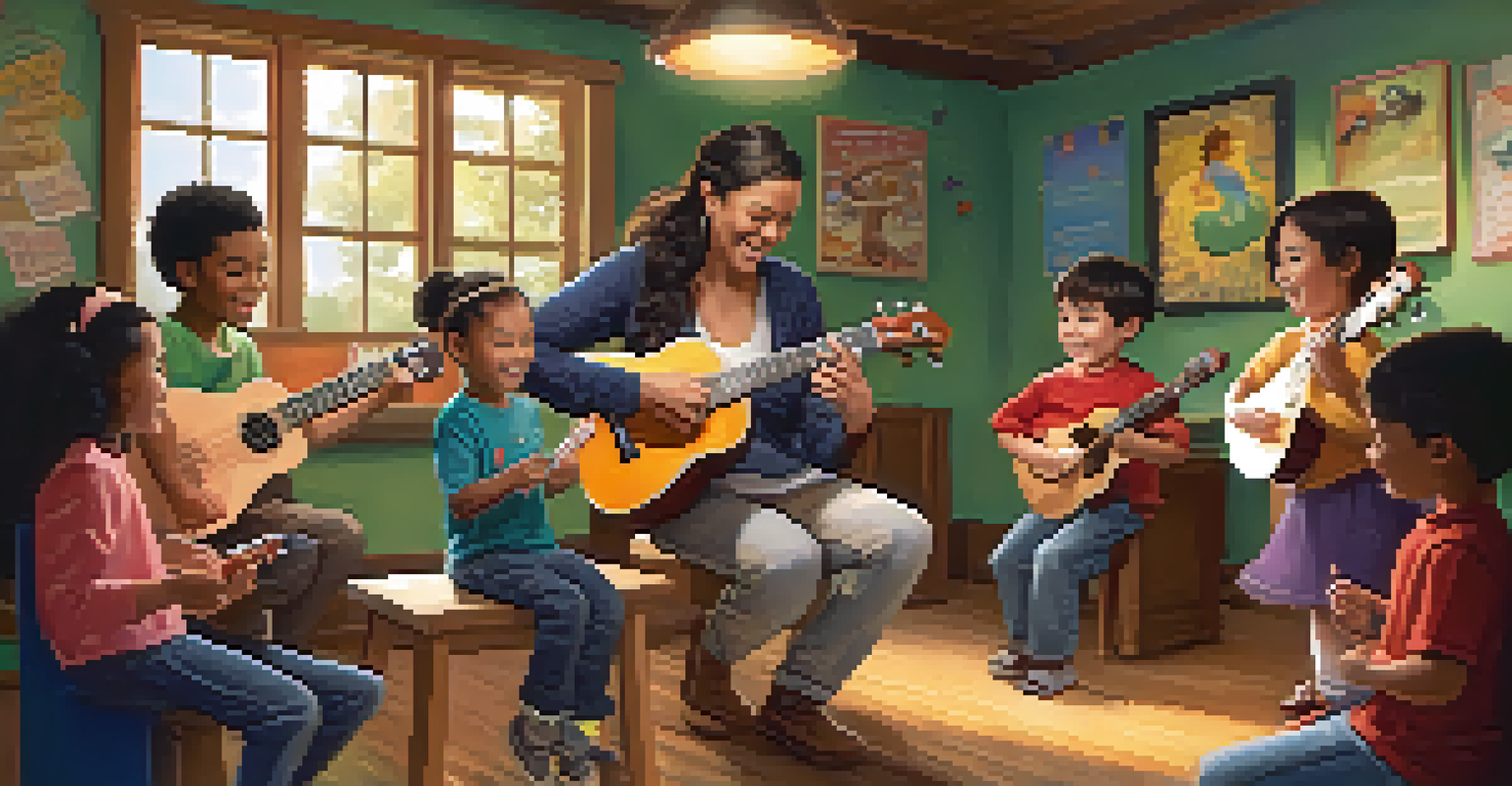Creating a Fun Ukulele Lesson Plan for Children

Understanding the Ukulele: A Brief Introduction for Kids
The ukulele is a small, four-stringed instrument that's easy to handle, making it perfect for young learners. Its cheerful sound can bring joy to any gathering, and it’s just the right size for small hands. By introducing the ukulele, we're not just teaching music; we're opening a door to creativity and self-expression.
Music is the shorthand of emotion.
To keep children engaged, start with a fun fact: did you know that the ukulele originated in Hawaii? This bit of trivia can spark their curiosity and help them connect with the instrument on a cultural level. Plus, who doesn't love a good story about music and islands?
Encouraging kids to explore the ukulele can boost their confidence, too. As they learn to play simple chords and songs, they experience the joy of creating music, which can lead to a lifelong passion for the arts.
Setting Goals: What Do We Want to Achieve?
Before diving into lessons, it's crucial to establish clear, achievable goals. Ask yourself what you want the children to learn by the end of the session. Whether it's mastering a simple song or understanding basic chords, setting specific goals gives direction to your lesson.

These goals should be fun and engaging, like playing a popular children's song they already know. This familiarity can help them feel more comfortable and excited about learning. Plus, achieving these goals will give them a sense of accomplishment.
Engaging Kids with the Ukulele
Introducing the ukulele fosters creativity and self-expression in children while providing a fun way to learn music.
Don’t forget to keep the goals flexible! Children learn at different paces, and adapting your lesson plan to fit their needs will keep the atmosphere positive and encouraging.
Gathering the Right Materials for Your Lesson
Having the right materials is key to a successful ukulele lesson. Make sure each child has access to a ukulele, preferably one that's age-appropriate and tuned. You’ll also want to gather song sheets, chord charts, and possibly some colorful instruments to keep the energy high.
The beautiful thing about learning is that no one can take it away from you.
Consider creating a visual aid, like a poster with chord diagrams, that kids can refer to during the lesson. Visual learning can be especially helpful for younger children, making it easier for them to grasp concepts quickly.
Lastly, don’t underestimate the power of fun accessories! Adding stickers or colorful straps to their ukuleles can make the instrument feel uniquely theirs, which adds an element of pride and excitement to the learning experience.
Warm-Up Activities: Getting Everyone Comfortable
Start your lesson with some fun warm-up activities to get everyone relaxed and ready to play. Simple exercises like finger stretches or clapping rhythms can help them get in the groove. Remember, the goal is to create an enjoyable atmosphere where kids feel free to express themselves.
You might even introduce a fun game that incorporates music, such as a musical chairs variation where they pass the ukulele around. This not only gets them moving but also encourages social interaction and teamwork.
Setting Achievable Goals
Establishing clear, flexible goals helps direct lessons and boosts children's confidence as they achieve musical milestones.
The key is to keep it light and fun. A positive start sets the tone for the rest of the lesson, helping kids feel more confident as they dive into playing the ukulele.
Introducing Basic Chords: The Building Blocks of Music
Once the kids are warmed up, it's time to introduce some basic chords. Start with simple ones like C, G, and F, which are commonly used in many songs. Explaining how these chords work will help them understand the foundation of music creation.
Using a visual aid, such as a chord chart, can significantly enhance their learning experience. Encourage them to practice transitioning between chords, emphasizing that it’s normal for their fingers to feel a bit awkward at first.
To keep things engaging, incorporate a song that uses these basic chords. Playing along to a familiar tune can make the learning process feel more like fun and less like a chore.
Choosing Fun Songs to Keep Kids Engaged
Selecting songs that kids love is vital for maintaining their interest and enthusiasm. Consider popular children's songs or catchy tunes from movies they enjoy. The familiarity of these songs can motivate them to practice and improve.
As you introduce each song, break it down into manageable sections. Teaching the chorus first can provide a quick win, allowing them to experience the joy of playing music right away. This sense of achievement will encourage them to learn more.
Choosing Familiar Songs
Selecting popular songs that kids love keeps them motivated and makes learning to play the ukulele an enjoyable experience.
Don't hesitate to let them suggest songs too! Allowing kids to have a say in what they play can make lessons feel more personal and engaging.
Closing the Lesson: Recap and Next Steps
As the lesson comes to a close, take a moment to recap what the kids have learned. Celebrate their achievements, big or small, to reinforce their progress. Acknowledging their efforts will boost their confidence and encourage them to keep practicing.
You might also want to assign a fun practice task for the next lesson, such as mastering a specific chord or song. This gives them a sense of purpose and something to look forward to when they return.

Finally, ask for feedback! Understanding what they enjoyed or found challenging can help you tailor future lessons, ensuring that each session is as engaging and effective as possible.